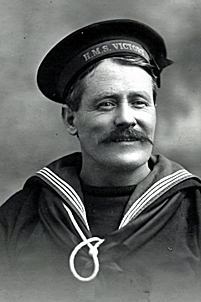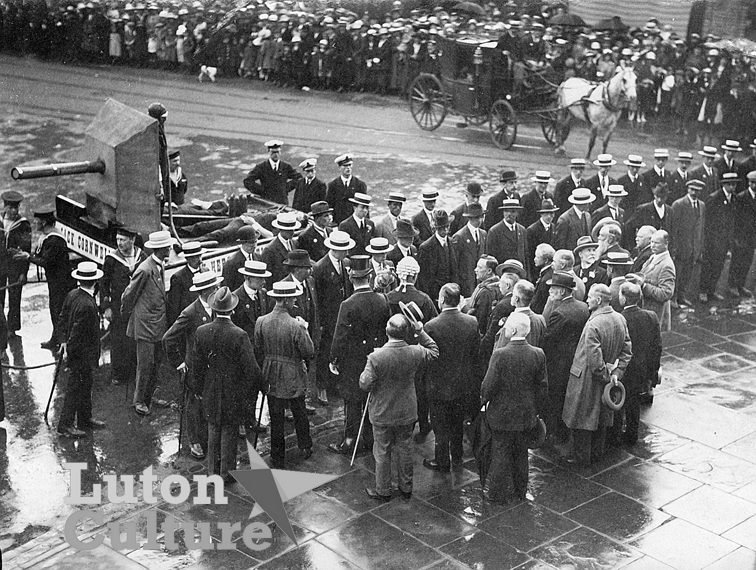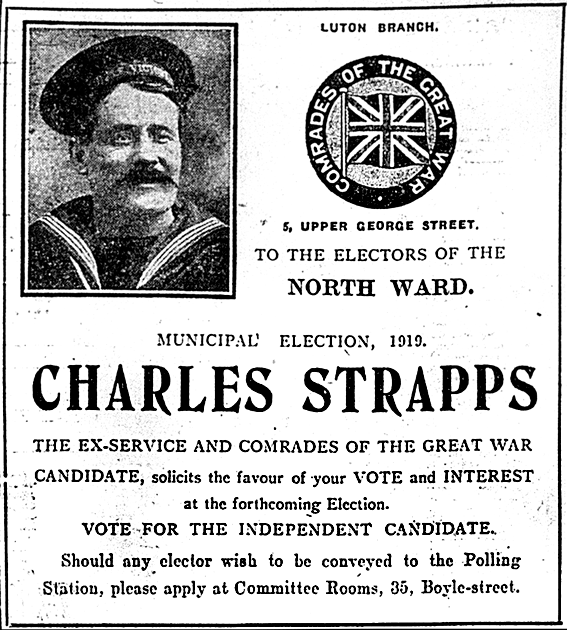This man may have been the inspiration behind the "Jack Cornwell VC" float which became a focal point of the Peace Day parade on July 19, 1919, that culminated in the notorious riot and burning of the Town Hall.
Former Petty Officer Charles Henry Strapps, pictured left, was licensee of The Rabbit pub in Old Bedford Road and was obviously proud of his naval past. His pub was a meeting place for the Comrades of the Great War organisation which belatedly entered the Cornwell* tableau, pictured below right, in the parade after it seemed ex-servicemen's organisations locally were going to follow the lead of their organisations nationally and boycott any Peace Day celebrations anywhere.
The link between Strapps and the Cornwell float came in a notice printed in a special Friday edition of the Saturday Telegraph on July 18th, 1919. It said: "Jack Cornwell VC. A tableau representing the boy hero will take part in the Peace Procession on Saturday. Will naval men on leave and demobilised men with uniforms wishing to take part kindly call and see Mr Strapps at The Rabbit, Old Bedford Road, at 8 pm today or attend there at 11.30 am on Saturday?"
In an article for the Bedfordshire Historical Record Society in 1978, historian Dr John Dony** wrote that "no association was indicated in the notice but Charles Strapps, an ex-petty officer in the Navy and landlord of The Rabbit, was known to be an active member of the Comrades".
But Strapps was not among the names of the General Committee of the Comrades published in notices in either The Luton News or Saturday Telegraph in 1919. The names listed were: H. Shepherd (Secretary), A. E. Talbot, A. E. Rickard, S. Bowles, H. Knott, A. N. Brown, P. W. Game, F. Arnell, J. H. Lambert, J. E. Buckingham, A. C. Toyer, H. J. Lambert, L. Baxter, F. W. Lawrence, C. C. Daniels.
To add to the mystery of Charles Strapps, an unaddressed postcard bearing Charles Strapps' image became part of the archives of The Luton News. On the reverse is written: "A short history to date - August 4th, 1914, to April 29th, 1915. Recalled a few days from HMS Fishguard before she foundered in the English Channel, September 14th [17th], 1914, losing the greater part of her crew. Joined HMS Venerable and was five times in action off Belgian Coast. October 1914 was lying close to HMS Bulwark when she blew up in Sheerness Harbour, with a loss of 800 lives. Changed position in the lane of three at 3 pm with HMS Formidable which was sunk by mine or torpedo at 2am, January 1st, 1915, while cruising in the English Channel, losing the greater part of her crew of 800 men."
The implication would be that this related to Strapps himself, who in the 1911 Census is described as a naval pensioner. The postcard photo - with the unexplained but perhaps aspirational "HMS Victory" headband - was also used in Strapps' pre-poll publicity for the November 1919 Luton Town Council elections, in which he failed to gain a North Ward seat as an independent representing the Comrades.The events of July 19th had obviously done nothing to further his later municipal election campaign. He finished fifth out of six candidates in North Ward in a low voter turnout of just over 44 per cent. The result was:
Osborne C. H. (Ind Lib) 1691 - elected
Linsell J. J. (Ind Lib) 1689 - elected
Knight T. H. (Lab) 1306
Mabley W. J. (Lab) 1183
Strapps C. (Comrades) 412
Unwin J. (Ind Cons) 335
Mr Strapps said after the count that unfortunately he belonged to the wrong trade [publican] to get much support in Luton.
"Too many non-conformists," cried someone at the poll declaration in the Plait Hall, while another cry was, "You have done your bit, and that is more than some of the Labour Party have".
Records show that Strapps, born in Lincoln on January 5th, 1869, to Charles and Elizabeth Strapps, was licensee of The Rabbit in 1910 (possibly he was the first licensee to take over after the pub was rebuilt in 1908) and was still listed there in a 1939 street directory, when his son Henry was publican.
He was described as a navy man in the 1901 Census, living at the Coast Guard Station at Salcombe Regis, near Honiton, Devon, with his wife Mabel (married 1897) and three children aged seven to 14, who were all born in Devon. He served in the Navy from 1884.
Charles Strapps died in December 1947, although no death notice or obituary notice appears to have been published in Luton to give any clues to his possible Peace Day involvement. His address at the time was 142 Cutenhoe Road, Luton.
* John Travers Cornwell was aged just 16 when, severely wounded and the only survivor at his post, he continued to man the only remaining operational gun on HMS Chester for 15 minutes during the Battle of Jutland on May 16th, 1916. He died in Grimsby General Hospital on June 2nd, 1916, and was posthumously awarded the Victoria Cross, the highest award for gallantry in the face of the enemy.
** Dr Dony had himself been at Wardown Park for the Peace Day celebrations and returned home past the deserted Town Hall at 9 pm that day, noticing that all but one of its windows had been broken. Later he was part of the crowd in George Street, but left without knowing the Town Hall was on fire.
[Sources: The Luton News archives and Find My Past website.]

